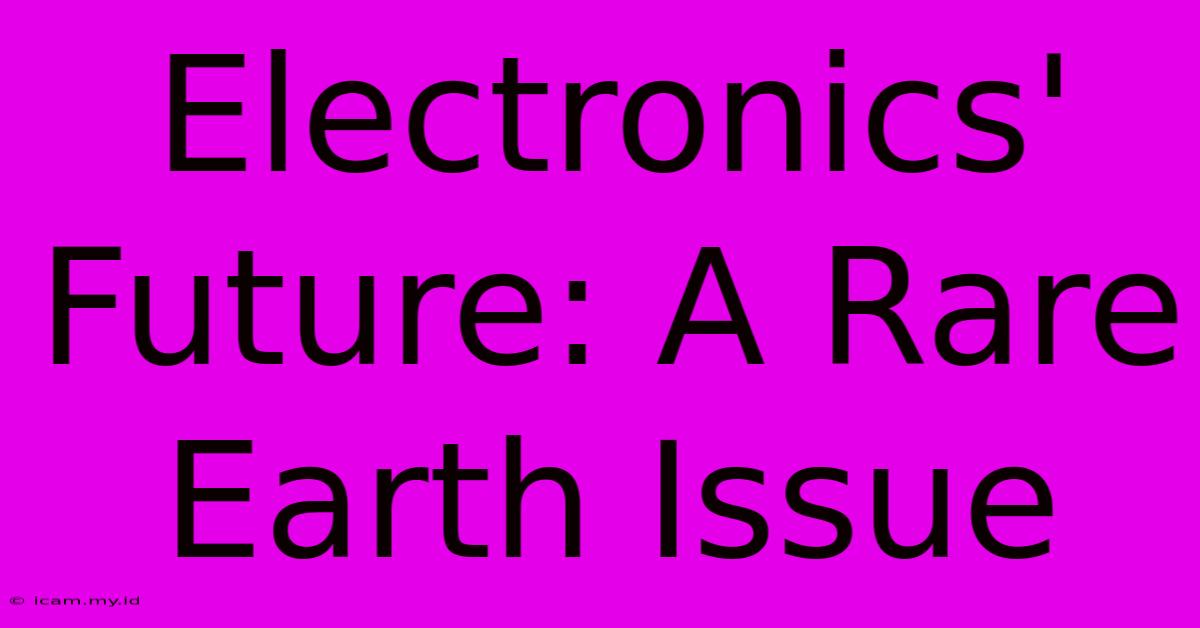Electronics' Future: A Rare Earth Issue

Find more detailed and interesting information on our website. Click the link below to start advanced information: Visit Best Website meltwatermedia.ca. Jangan lewatkan!
Table of Contents
Electronics' Future: A Rare Earth Issue
The world is increasingly reliant on electronics. From smartphones and laptops to electric vehicles and renewable energy technologies, our daily lives are interwoven with devices that rely heavily on rare earth elements (REEs). However, the future of electronics is inextricably linked to the sustainable sourcing and responsible management of these crucial materials. The current reliance on REEs presents a significant challenge, forcing us to confront the complex interplay between technological advancement, environmental concerns, and geopolitical stability.
What are Rare Earth Elements?
Rare earth elements aren't actually that rare; they're found in the Earth's crust in relatively significant quantities. However, their "rare" designation stems from the fact that they are rarely found in high concentrations, making their extraction and processing complex and expensive. This group comprises 17 elements: scandium and yttrium, plus the 15 lanthanides (lanthanum, cerium, praseodymium, neodymium, promethium, samarium, europium, gadolinium, terbium, dysprosium, holmium, erbium, thulium, ytterbium, and lutetium).
These elements possess unique magnetic, luminescent, and catalytic properties, making them indispensable in a wide range of electronic devices and technologies. For instance:
- Neodymium: Crucial for powerful permanent magnets used in wind turbines, electric vehicle motors, and hard disk drives.
- Dysprosium: Essential for enhancing the performance of neodymium magnets, particularly at high temperatures.
- Yttrium: Used in the production of high-performance ceramics and phosphors in flat-screen displays.
- Cerium: A key component in catalytic converters for automobiles and polishing compounds for glass.
The Geopolitical Landscape of Rare Earths
The global supply chain for REEs is highly concentrated, with China currently dominating the market, controlling a significant portion of mining, processing, and refining. This dominance raises concerns about potential supply disruptions, price volatility, and geopolitical leverage. This dependence on a single nation creates vulnerabilities for other countries reliant on these materials.
Diversifying the sources of REEs is paramount. Several countries, including the United States, Australia, and Canada, are investing in exploration and development of their own REE resources. However, establishing a robust and sustainable supply chain requires significant investment in mining infrastructure, processing facilities, and refining capabilities. This process is time-consuming and challenging, requiring overcoming regulatory hurdles, environmental impact assessments, and securing funding.
Environmental Concerns: The Price of Progress
The extraction and processing of REEs are not without environmental consequences. Mining activities can lead to habitat destruction, water pollution, and soil degradation. The refining process often involves the use of harsh chemicals, generating hazardous waste that requires careful management. The environmental impact necessitates the development of more sustainable and environmentally friendly mining and processing techniques. This includes exploring options like bioleaching and improved waste management strategies to minimize the ecological footprint of REE extraction.
Furthermore, the carbon footprint associated with REE mining and processing is substantial. Reducing this impact requires improvements in energy efficiency and the adoption of renewable energy sources throughout the supply chain.
The Push for Sustainable Solutions
Addressing the challenges posed by REE dependence requires a multi-pronged approach focusing on several key areas:
-
Recycling and Reuse: Recycling REEs from end-of-life electronics is crucial for reducing reliance on primary mining and mitigating environmental impacts. Improving recycling technologies and implementing effective collection and processing systems are essential steps. Legislation incentivizing recycling and extended producer responsibility (EPR) schemes can play a critical role.
-
Substitution and Innovation: Research and development efforts are focused on finding alternative materials that can replace REEs in certain applications. This involves exploring materials with similar properties or developing new technologies that require fewer or no REEs.
-
Urban Mining: Urban mining, which involves recovering valuable materials from electronic waste, offers a promising avenue for REE recovery. This approach not only helps conserve resources but also reduces the environmental burden associated with landfilling e-waste.
-
Improved Mining Practices: Adopting sustainable mining practices, including minimizing waste generation, reducing water consumption, and implementing robust environmental monitoring, is crucial for minimizing the environmental impact of REE extraction.
-
International Cooperation: International collaboration is essential for coordinating efforts to secure a stable and sustainable supply of REEs. This includes sharing best practices, promoting responsible mining standards, and fostering cooperation on research and development.
The Future of Electronics: A Path Towards Sustainability
The future of electronics hinges on our ability to address the challenges posed by REE dependence. A holistic approach encompassing sustainable mining, efficient recycling, technological innovation, and international cooperation is essential. By prioritizing responsible sourcing, investing in innovative technologies, and promoting circular economy models, we can pave the way for a future where technological advancement and environmental sustainability coexist.
The transition to a more sustainable electronics industry will require significant effort from governments, industries, and consumers alike. Implementing policies that incentivize responsible sourcing and recycling, investing in research and development of alternative materials, and fostering consumer awareness about the importance of responsible e-waste management are all crucial steps. Ultimately, securing a sustainable future for electronics requires a concerted global effort to address this complex and critical issue. The time to act is now; the future of our technological landscape depends on it.

Thank you for visiting our website. Electronics' Future: A Rare Earth Issue. We hope the information we provide is helpful to you. Feel free to contact us if you have any questions or need additional assistance. See you next time, and don't forget to save this page!
Kami berterima kasih atas kunjungan Anda untuk melihat lebih jauh. Electronics' Future: A Rare Earth Issue. Informasikan kepada kami jika Anda memerlukan bantuan tambahan. Tandai situs ini dan pastikan untuk kembali lagi segera!
Featured Posts
-
Ananda Krishnan Media Mogul Dies Aged 86
Nov 28, 2024
-
Takaful Explains Medical Insurance Cost Increase
Nov 28, 2024
-
2024 Automation I Io T And Beyond
Nov 28, 2024
-
Vietnam Tycoon Faces Lethal Injection
Nov 28, 2024
-
Karius Retirement Kyivs Lingering Impact
Nov 28, 2024
